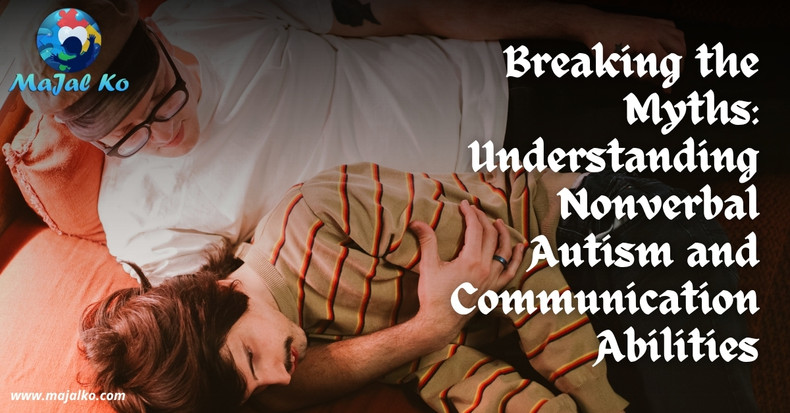Nonverbal autism remains widely misunderstood, often leading to misconceptions that can impact how society perceives and interacts with nonverbal individuals. Many assume that being nonverbal means being unable to communicate, think, or express emotions effectively. However, communication is far more diverse than simply speaking aloud. Gestures and facial expressions sometimes tell us how a person feels without verbally expressing it. Let’s explore and break some of the most common myths surrounding nonverbal autism while highlighting the many ways individuals communicate.
Myth #1: Nonverbal Means Non-Communicative
One of the biggest misconceptions is that nonverbal individuals are unable to communicate at all. In reality, many people with nonverbal autism have rich inner lives and thoughts that they express through alternative communication methods. These may include:
- Augmentative and Alternative Communication (AAC) devices – Technology that converts text or symbols into spoken words (Beukelman & Mirenda, 2013).
- Sign language or gestures – Some individuals use American Sign Language (ASL) or customized hand signs (Gillen, 2018).
- Writing or typing – Many nonverbal individuals can communicate effectively through written text or typing (Wodka et al., 2013).
- Picture Exchange Communication System (PECS) – A tool that allows individuals to convey their needs and thoughts using images (Frost & Bondy, 2002).
- Body language and facial expressions – Nonverbal cues such as eye contact, gestures, and facial expressions can convey emotions and intentions.
Myth #2: Nonverbal Individuals Have Intellectual Disabilities
There is a harmful stereotype that if a person cannot speak, they must lack intelligence. However, intelligence is not determined by speech ability. Many nonverbal individuals are highly intelligent, creative, and articulate in their own ways. Some well-known nonverbal autistic individuals, such as authors and advocates, have demonstrated that speech is not the only way to share thoughts, emotions, and ideas. Apraxia, a speech disorder that is common to children with autism (Biklen, 2005). According to Google, it affects about 65% of children with autism. Apraxia makes a sound production difficult as it affects the person's ability to plan and execute voluntary movements. This is similar to what we see from people who have a brain tumor, or experienced a traumatic brain injury, and stroke.
Myth #3: They Don’t Want to Communicate
Another myth is that nonverbal autistic individuals lack the desire to communicate. On the contrary, they often have a strong need to express themselves but may face barriers due to motor challenges, sensory processing differences, or difficulty with verbal speech from apraxia. Given the right tools and support, many nonverbal individuals thrive in communication (Kasari et al., 2014).
Myth #4: Nonverbal Autism is a Permanent Condition
While some individuals remain nonverbal throughout their lives, others develop speech over time with therapy, practice, and accommodations. The journey of each individual is unique, and progress varies widely from person to person. It is essential to focus on communication rather than just verbal speech (Tager-Flusberg & Kasari, 2013). Early intervention is key.
Supporting Nonverbal Individuals
Understanding and supporting nonverbal individuals requires patience, education, and the willingness to adapt communication methods. Here are some ways to foster meaningful interactions:
- Learn and use their preferred communication method – Whether it’s an AAC (Augmentative and Alternative Communication) device, sign language, or written text, adapting to their needs helps build meaningful connections.
- Encourage self-expression – Allow them to communicate at their own pace without pressure.
- Be patient and observant – Recognize nonverbal cues and respect their responses.
- Advocate for inclusivity – Support access to communication tools and education that empowers nonverbal individuals.
Conclusion
Breaking the myths about nonverbal autism allows us to create a more inclusive and understanding society. Communication is not limited to spoken words—every individual has a voice that deserves to be heard in whatever form it takes. By embracing diverse communication methods, we can foster greater connections and empower nonverbal individuals to express themselves freely.
References
- Beukelman, D., & Mirenda, P. (2013). Augmentative and Alternative Communication: Supporting Children and Adults with Complex Communication Needs. Brookes Publishing.
- Biklen, D. (2005). Autism and the Myth of the Person Alone. NYU Press.
- Frost, L., & Bondy, A. (2002). The Picture Exchange Communication System (PECS). Pyramid Educational Products.
- Gillen, J. (2018). Enhancing Learning and Teaching with Nonverbal Communication. Routledge.
- Kasari, C., Brady, N., Lord, C., & Tager-Flusberg, H. (2014). "Assessing the Minimally Verbal School-Aged Child with Autism Spectrum Disorder." Autism Research, 7(4), 310–325.
- Tager-Flusberg, H., & Kasari, C. (2013). "Minimally Verbal School-Aged Children with Autism Spectrum Disorder: The Neglected End of the Spectrum." Autism Research, 6(6), 468–478.
- Wodka, E. L., Mathy, P., & Kalb, L. (2013). "Predicting Language Outcomes in Children with Autism Spectrum Disorders: Age and Cognitive Ability Matter." Autism Research, 6(5), 605–615.

